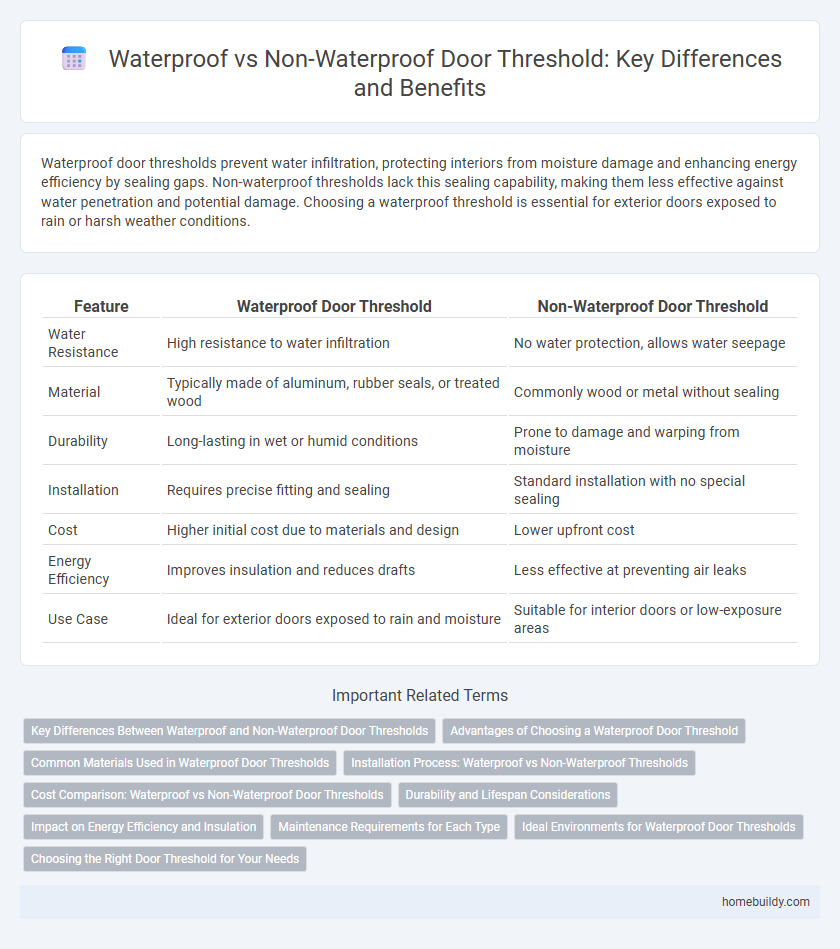Waterproof door thresholds prevent water infiltration, protecting interiors from moisture damage and enhancing energy efficiency by sealing gaps. Non-waterproof thresholds lack this sealing capability, making them less effective against water penetration and potential damage. Choosing a waterproof threshold is essential for exterior doors exposed to rain or harsh weather conditions.
Table of Comparison
| Feature | Waterproof Door Threshold | Non-Waterproof Door Threshold |
|---|---|---|
| Water Resistance | High resistance to water infiltration | No water protection, allows water seepage |
| Material | Typically made of aluminum, rubber seals, or treated wood | Commonly wood or metal without sealing |
| Durability | Long-lasting in wet or humid conditions | Prone to damage and warping from moisture |
| Installation | Requires precise fitting and sealing | Standard installation with no special sealing |
| Cost | Higher initial cost due to materials and design | Lower upfront cost |
| Energy Efficiency | Improves insulation and reduces drafts | Less effective at preventing air leaks |
| Use Case | Ideal for exterior doors exposed to rain and moisture | Suitable for interior doors or low-exposure areas |
Key Differences Between Waterproof and Non-Waterproof Door Thresholds
Waterproof door thresholds are designed with materials like rubber seals and aluminum to prevent water infiltration, ensuring durability and protection against moisture damage. Non-waterproof door thresholds typically lack sealing features, making them more susceptible to water seepage and potential structural issues over time. Choosing waterproof thresholds enhances weather resistance and energy efficiency by creating a tight barrier against external elements.
Advantages of Choosing a Waterproof Door Threshold
Waterproof door thresholds prevent water infiltration, reducing the risk of structural damage and mold growth in entryways. They enhance energy efficiency by creating a tighter seal against air and moisture leaks, lowering heating and cooling costs. These thresholds increase durability and longevity of doors, making them ideal for homes in wet climates or areas prone to heavy rainfall.
Common Materials Used in Waterproof Door Thresholds
Common materials used in waterproof door thresholds include aluminum, stainless steel, and composite polymers, which provide enhanced resistance to water damage and corrosion. These materials often feature rubber or silicone seals that create a tight barrier against moisture infiltration. In contrast, non-waterproof thresholds typically use untreated wood or basic metals that lack effective sealing properties and durability in wet conditions.
Installation Process: Waterproof vs Non-Waterproof Thresholds
Waterproof door thresholds require precise sealing and often include integrated drainage channels or weather stripping for effective water resistance, making installation more complex than non-waterproof thresholds. Non-waterproof thresholds typically involve simpler installation steps, such as direct anchoring without specialized sealing components, suitable for interior or low-exposure areas. Proper surface preparation and alignment are critical in both to ensure durability and prevent drafts or water intrusion.
Cost Comparison: Waterproof vs Non-Waterproof Door Thresholds
Waterproof door thresholds typically range from $50 to $150, reflecting their advanced sealing materials and installation complexity, while non-waterproof thresholds generally cost between $20 and $60 due to simpler designs and materials. The higher initial investment in waterproof thresholds often results in reduced maintenance expenses and enhanced protection against water damage, potentially lowering long-term repair costs. Non-waterproof thresholds may require frequent replacements or repairs in areas prone to moisture, increasing overall lifecycle expenses despite lower upfront costs.
Durability and Lifespan Considerations
Waterproof door thresholds are constructed with moisture-resistant materials such as aluminum or stainless steel, enhancing durability by preventing water damage, warping, and corrosion, thus extending their lifespan significantly. Non-waterproof door thresholds, often made from wood or basic metals, are more susceptible to deterioration from exposure to water and humidity, resulting in reduced durability and frequent replacements. Choosing waterproof thresholds ensures long-term performance, especially in areas prone to moisture and heavy foot traffic.
Impact on Energy Efficiency and Insulation
Waterproof door thresholds significantly improve energy efficiency by creating a tight seal that prevents air and moisture infiltration, reducing heat loss and lowering heating and cooling costs. Non-waterproof thresholds often allow drafts and water seepage, compromising insulation and increasing energy consumption. Choosing a waterproof door threshold enhances indoor comfort by maintaining consistent thermal barriers and protecting against external weather conditions.
Maintenance Requirements for Each Type
Waterproof door thresholds require minimal maintenance due to their ability to prevent water damage and resist mold and rust, typically needing only occasional cleaning and inspection. Non-waterproof door thresholds demand more frequent upkeep, including regular sealing, protection against moisture infiltration, and prompt repairs to prevent rotting and structural damage. Choosing a waterproof threshold significantly reduces long-term maintenance efforts and extends the lifespan of entryways.
Ideal Environments for Waterproof Door Thresholds
Waterproof door thresholds are essential for environments exposed to heavy moisture, such as exterior entrances, basements, and areas near swimming pools or spas, where water intrusion can cause damage or mold growth. They provide a robust barrier against water seepage, ensuring durability and maintaining indoor air quality by preventing dampness. Non-waterproof door thresholds are better suited for interior spaces with minimal moisture exposure, like dry offices or living rooms, where water resistance is less critical.
Choosing the Right Door Threshold for Your Needs
Waterproof door thresholds effectively prevent water infiltration, making them ideal for exterior doors exposed to rain or snow, while non-waterproof thresholds are suitable for interior use where moisture exposure is minimal. Materials like aluminum or vinyl with rubber seals enhance waterproof performance, providing durability and protection against weather elements. Selecting the right door threshold depends on environmental conditions, door location, and desired moisture resistance to ensure long-term functionality and energy efficiency.
Waterproof door threshold vs Non-waterproof door threshold Infographic

 homebuildy.com
homebuildy.com